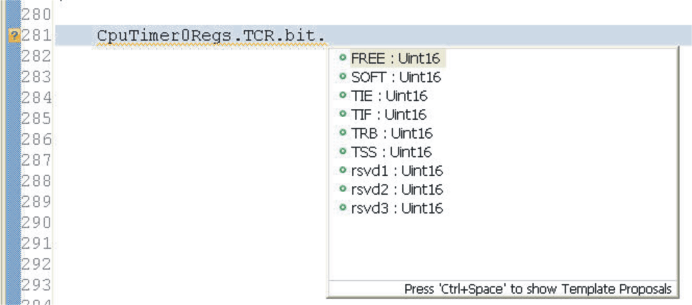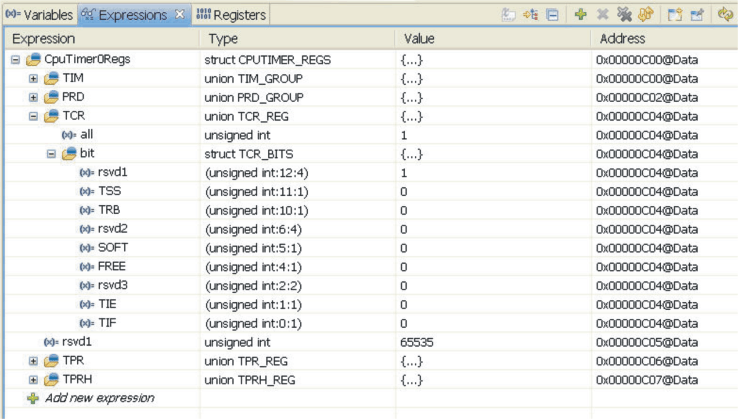SPRAA85E November 2005 – December 2017 SM320F2812 , SM320F2812-EP , TMS320F280021 , TMS320F280021-Q1 , TMS320F280023 , TMS320F280023-Q1 , TMS320F280023C , TMS320F280025 , TMS320F280025-Q1 , TMS320F280025C , TMS320F280025C-Q1 , TMS320F280040-Q1 , TMS320F280040C-Q1 , TMS320F280041 , TMS320F280041-Q1 , TMS320F280041C , TMS320F280041C-Q1 , TMS320F280045 , TMS320F280048-Q1 , TMS320F280048C-Q1 , TMS320F280049 , TMS320F280049-Q1 , TMS320F280049C , TMS320F280049C-Q1 , TMS320F2801 , TMS320F2801-Q1 , TMS320F2802 , TMS320F2802-Q1 , TMS320F28044 , TMS320F2806 , TMS320F2806-Q1 , TMS320F28062 , TMS320F28062-Q1 , TMS320F28062F , TMS320F28062F-Q1 , TMS320F28063 , TMS320F28064 , TMS320F28065 , TMS320F28066 , TMS320F28066-Q1 , TMS320F28067 , TMS320F28067-Q1 , TMS320F28068F , TMS320F28068M , TMS320F28069 , TMS320F28069-Q1 , TMS320F28069F , TMS320F28069F-Q1 , TMS320F28069M , TMS320F28069M-Q1 , TMS320F28075 , TMS320F28075-Q1 , TMS320F2808 , TMS320F2808-Q1 , TMS320F2809 , TMS320F2810 , TMS320F2810-Q1 , TMS320F2811 , TMS320F2811-Q1 , TMS320F2812 , TMS320F2812-Q1 , TMS320F28232 , TMS320F28232-Q1 , TMS320F28234 , TMS320F28234-Q1 , TMS320F28235 , TMS320F28235-Q1 , TMS320F28332 , TMS320F28333 , TMS320F28334 , TMS320F28335 , TMS320F28335-Q1 , TMS320F28374D , TMS320F28374S , TMS320F28375D , TMS320F28375S , TMS320F28375S-Q1 , TMS320F28376D , TMS320F28376S , TMS320F28377D , TMS320F28377D-EP , TMS320F28377D-Q1 , TMS320F28377S , TMS320F28377S-Q1 , TMS320F28379D , TMS320F28379D-Q1 , TMS320F28379S , TMS320R2811
-
Programming TMS320x28xx and TMS320x28xxx Peripherals in C/C++
- Trademarks
- 1 Introduction
- 2 Traditional #define Approach
- 3 Bit Field and Register-File Structure Approach
- 4 Bit Field and Register-File Structure Advantages
- 5 Code Size and Performance Using Bit Fields
- 6 Read-Modify-Write Considerations When Using Bit Fields
- 7 Special Case Peripherals
- 8 C2000 Peripheral Driver Library Approach
- 9 Code Size and Performance Using Driverlib
- 10 Comparing and Combining Approaches
- 11 References
- Revision History
4 Bit Field and Register-File Structure Advantages
The bit field and register-file structure approach has many advantages that include:
- Register-file structures and bit fields are already available from Texas Instruments.
- Using bit fields produces code that is easy-to-write, easy-to-read, easy-to-update, and efficient.
In the C/C++ Header Files and Peripheral Examples, the register-file structures and bit fields have been implemented for all peripherals on the C28x cores of the TMS320x28xx and TMS320x28xxx devices. The included header files can be used as-is or extended to suit your particular needs.
The complete implementation is available in the software downloads from TI's website as shown in Section 1.
Bit fields can be manipulated quickly without the need to determine a register mask value. In addition, you have the flexibility to access registers either by bit field or as a single quantity as shown in Example 11. Code written using the register file structures also generates very efficient code. Code efficiency will be discussed in Section 5.
- Bit fields take advantage of the Code Composer Studio editors auto complete feature.
At first it may seem that variable names are harder to remember and longer to type when using register-file structures and bit fields. The Code Composer Studio editor provides a list of possible structure/bit field elements as you type; this makes it easier to write code without referring to documentation for register and bit field names. An example of the auto completion feature for the CPU-Timer TCR register is shown in Figure 3.
 Figure 3. Code Composer Studio v5.1 Autocomplete Feature
Figure 3. Code Composer Studio v5.1 Autocomplete Feature - Increases the effectiveness of the Code Composer Studio Watch Window.
You can add and expand register-file structures in Code Composer Studio's watch window as shown in Figure 4. Bit field values are read directly without extracting their value by hand.
 Figure 4. Code Composer Studio v5.1 Expression Window
Figure 4. Code Composer Studio v5.1 Expression Window